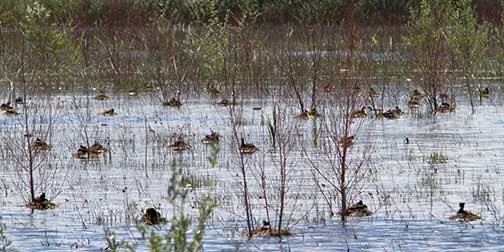 |
Previous Issues |
| Cedar Mill Community Website |
|
Search the Cedar Mill News: |
About The Cedar Mill News |
|
|||||||
| Volume 10, Issue 7 | July 2012 |
||||||
Babies
|
 |
| Eared grebes on nests in the Lower Klamath National Wildlife Refuge, June 2012. Photo © 2012 by Jeff Young. |
After all the frenzy of the mating calls, the dances, and the nest building, we now have the product of all that effort—many chicks in our yards in Cedar Mill. This year I was lucky enough to have a pair of nesting Black Capped Chickadees in a birdhouse on my deck. These birds are very comfortable in urban areas so they paid no attention to our rowdy deck parties or the lawn mower or the lights. They just persisted in feeding large bugs to their group of young, and eventually all of them left the nest. We still see them flying around our yard in a group of four. The chicks are obviously “fluffier” than the parents and on occasion do the “begging” routine of fluttering the feathers and opening their large mouths to have suet and bugs just dropped in. This reminds me of our youngest son who has metaphorically a large mouth with his college tuition bills!
I have been amazed at the diversity of parental behaviors among the species in my yard. Some groups of young and parents stay together for several months in large flocks (geese, for example) and others seem to disperse relatively quickly— I regularly see Spotted towhee young foraging all alone.
This reminds me of the Margaret Small “Our Babies, Ourselves” book, about ethnopediatrics. She studied various groups of people around the world to understand differences in child rearing techniques. She found huge variety in variables such as how much mothers smiled at babies—highest in the US which values “happiness in childhood” more than in traditional African or Asian cultures she studied—and sleep patterns, and language patterns. I have found similar incredible disparities just in my own yard.
One of the things I like most about looking outside is the way it helps us understand our natural world in more detail, rather than assuming that things fit our preconceived notions. For example, I saw some Anna’s hummingbirds visit the holes that Sapsuckers had drilled into willow trees—the hummingbirds were eating the rich sap while the sapsuckers had eaten the trapped insects. If you look around you can see amazing diversity in your own back yard and elsewhere. Columbia Edgewater Country Club has a nesting camera showing chicks of Swallows with huge mouths anticipating the parent’s return, and you can observe the shuffling of the larger chicks that get most of the food. All of these natural events are infinitely interesting if one takes a closer look.
Lauretta Young MD is the Director of Intitiative for Self Care Integrative Medicine project for Students at OHSU and also teaches at PSU. She leads birding tours in Cedar Mill and beyond. Check out the web site at www.portlandbirdwatching.com
Published monthly by Pioneer Marketing & Design
Publisher/Editor:Virginia Bruce
503-803-1813
PO Box 91061
Portland, Oregon 97291
© 2012